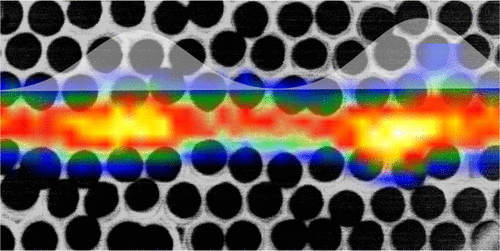当前位置:
X-MOL 学术
›
ACS Photonics
›
论文详情
Our official English website, www.x-mol.net, welcomes your feedback! (Note: you will need to create a separate account there.)
Anderson Localization of Visible Light on a Nanophotonic Chip
ACS Photonics ( IF 7 ) Pub Date : 2017-09-06 00:00:00 , DOI: 10.1021/acsphotonics.7b00517 Tom Crane 1 , Oliver Joe Trojak 1 , Juan Pablo Vasco 2 , Stephen Hughes 2 , Luca Sapienza 1
ACS Photonics ( IF 7 ) Pub Date : 2017-09-06 00:00:00 , DOI: 10.1021/acsphotonics.7b00517 Tom Crane 1 , Oliver Joe Trojak 1 , Juan Pablo Vasco 2 , Stephen Hughes 2 , Luca Sapienza 1
Affiliation

|
Technological advances allow the control of light at the nanoscale and to strongly enhance the light–matter interaction in highly engineered devices. Enhancing the light–matter interaction is needed for applications in research areas such as quantum technology, energy harvesting, sensing, and biophotonics. Here, we show that a different approach, based on the use of disorder, rather than the precise engineering of the devices, and fabrication imperfections as a resource, can allow the efficient trapping of visible light on a chip. We demonstrate, for the first time to our knowledge, Anderson localization of light at visible wavelengths in a nanophotonic chip. Remarkably, we prove that disorder-induced localization is more efficient in confining visible light than highly engineered optical cavities, thus reversing the trend observed so far. We measure light-confinement quality factors approaching 10 000 that are significantly higher than values previously reported in two-dimensional photonic crystal cavities. These measurements are well explained using a three-dimensional Bloch mode expansion technique, where we also extract the mode quality factors and effective mode volume distributions of the localized modes. Furthermore, by implementing a sensitive imaging technique, we directly visualize the localized modes and measure their spatial extension. Even though the position where the cavities appear is not controlled, given the multiple scattering process at the basis of their formation, we are able to locate with nanometer-scale accuracy the position of the optical cavities. This is important for the deterministic coupling of emitters to the disorder-induced optical cavities and for assessing light localization. Our results show the potential of disorder as a novel resource for the efficient confinement of light and for the enhancement of the light–matter interaction in the visible range of wavelengths.
中文翻译:

纳米光子芯片上可见光的安德森定位
技术的进步允许在纳米级控制光,并在高度工程化的设备中极大地增强了光与物质的相互作用。在诸如量子技术,能量收集,传感和生物光子学等研究领域的应用中,需要增强光与物质的相互作用。在这里,我们展示了一种基于无序使用的方法,而不是基于设备的精确工程以及制造缺陷作为资源的另一种方法,可以有效地将可见光捕获在芯片上。据我们所知,我们第一次证明了纳米光子芯片中可见光波长处的安德森定位。值得注意的是,我们证明与高度工程化的光学腔相比,无序诱发的局限性在限制可见光方面更有效,从而扭转了迄今为止观察到的趋势。我们测量的光限制质量因子接近1万,远高于先前在二维光子晶体腔中报告的值。使用三维布洛赫(Bloch)模式扩展技术可以很好地解释这些测量,我们还可以提取模式质量因子和局部模式的有效模式体积分布。此外,通过实施敏感的成像技术,我们可以直接可视化本地化模式并测量其空间扩展。即使空洞的出现位置不受控制,但在其形成的基础上考虑了多次散射过程,我们仍可以纳米级精度定位光学空洞的位置。这对于确定性地将发射器耦合到由无序引起的光腔以及评估光的定位非常重要。我们的结果表明,无序作为一种新资源的潜力,可以有效地限制光并增强可见光波长范围内的光-物质相互作用。
更新日期:2017-09-06
中文翻译:

纳米光子芯片上可见光的安德森定位
技术的进步允许在纳米级控制光,并在高度工程化的设备中极大地增强了光与物质的相互作用。在诸如量子技术,能量收集,传感和生物光子学等研究领域的应用中,需要增强光与物质的相互作用。在这里,我们展示了一种基于无序使用的方法,而不是基于设备的精确工程以及制造缺陷作为资源的另一种方法,可以有效地将可见光捕获在芯片上。据我们所知,我们第一次证明了纳米光子芯片中可见光波长处的安德森定位。值得注意的是,我们证明与高度工程化的光学腔相比,无序诱发的局限性在限制可见光方面更有效,从而扭转了迄今为止观察到的趋势。我们测量的光限制质量因子接近1万,远高于先前在二维光子晶体腔中报告的值。使用三维布洛赫(Bloch)模式扩展技术可以很好地解释这些测量,我们还可以提取模式质量因子和局部模式的有效模式体积分布。此外,通过实施敏感的成像技术,我们可以直接可视化本地化模式并测量其空间扩展。即使空洞的出现位置不受控制,但在其形成的基础上考虑了多次散射过程,我们仍可以纳米级精度定位光学空洞的位置。这对于确定性地将发射器耦合到由无序引起的光腔以及评估光的定位非常重要。我们的结果表明,无序作为一种新资源的潜力,可以有效地限制光并增强可见光波长范围内的光-物质相互作用。



























 京公网安备 11010802027423号
京公网安备 11010802027423号